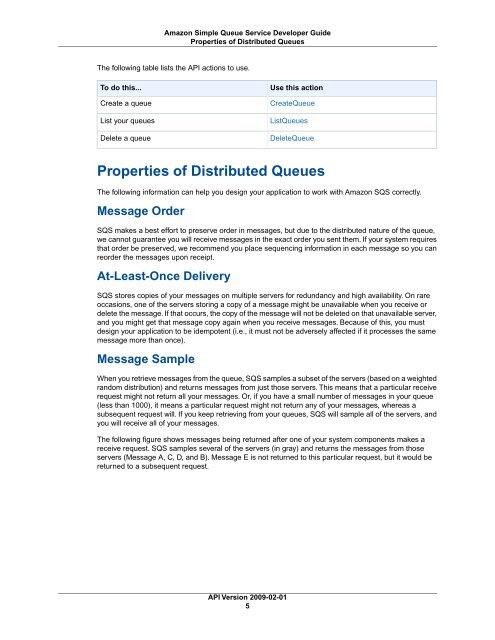sqs-dg-2009-02-01
You also want an ePaper? Increase the reach of your titles
YUMPU automatically turns print PDFs into web optimized ePapers that Google loves.
Amazon Simple Queue Service Developer Guide<br />
Properties of Distributed Queues<br />
The following table lists the API actions to use.<br />
To do this...<br />
Create a queue<br />
List your queues<br />
Delete a queue<br />
Use this action<br />
CreateQueue<br />
ListQueues<br />
DeleteQueue<br />
Properties of Distributed Queues<br />
The following information can help you design your application to work with Amazon SQS correctly.<br />
Message Order<br />
SQS makes a best effort to preserve order in messages, but due to the distributed nature of the queue,<br />
we cannot guarantee you will receive messages in the exact order you sent them. If your system requires<br />
that order be preserved, we recommend you place sequencing information in each message so you can<br />
reorder the messages upon receipt.<br />
At-Least-Once Delivery<br />
SQS stores copies of your messages on multiple servers for redundancy and high availability. On rare<br />
occasions, one of the servers storing a copy of a message might be unavailable when you receive or<br />
delete the message. If that occurs, the copy of the message will not be deleted on that unavailable server,<br />
and you might get that message copy again when you receive messages. Because of this, you must<br />
design your application to be idempotent (i.e., it must not be adversely affected if it processes the same<br />
message more than once).<br />
Message Sample<br />
When you retrieve messages from the queue, SQS samples a subset of the servers (based on a weighted<br />
random distribution) and returns messages from just those servers. This means that a particular receive<br />
request might not return all your messages. Or, if you have a small number of messages in your queue<br />
(less than 1000), it means a particular request might not return any of your messages, whereas a<br />
subsequent request will. If you keep retrieving from your queues, SQS will sample all of the servers, and<br />
you will receive all of your messages.<br />
The following figure shows messages being returned after one of your system components makes a<br />
receive request. SQS samples several of the servers (in gray) and returns the messages from those<br />
servers (Message A, C, D, and B). Message E is not returned to this particular request, but it would be<br />
returned to a subsequent request.<br />
API Version <strong>2009</strong>-<strong>02</strong>-<strong>01</strong><br />
5

















